- +91 9820036852
- sanjeev.jain@hiranandanihospital.org
- drsanjain@hotmail.com
Computer Assisted Knee Replacement
Knee and hip replacement are the commonest surgery in joint replacement as knee and hip arthritis is common.
Computer Assisted Knee Replacement
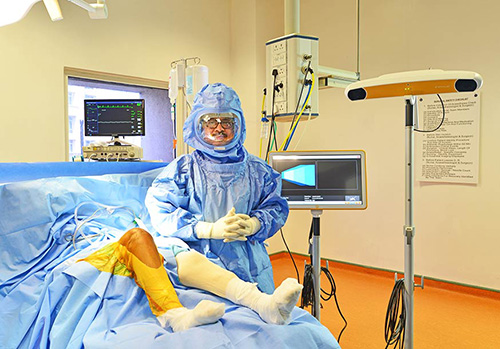
Dr Sanjeev Jain performs all his joint replacement surgeries using latest state of the art navigation system for knee replacement. Computer-aided methods in joint replacement improve the precision and accuracy of implant positioning and ligament balancing, producing better clinical results that improve the life of the implants.
Why Computer Assisted Surgery?
Factors affecting prosthetic lifespan vary. Ones of the most important factors are the accuracy of prosthesis placement and the restoration of surrounding muscle and ligament balance. This relies mostly on the orthopedic surgeon's skill and judgment. However, research has shown that incorrect placement still occur even with the most skilled and experienced surgeons. The chance for incorrect prosthetic placement will be greater in a less skilled or inexperienced surgeon. Therefore, computer technology has been introduced to assist in more accurate positioning of prosthetic components, allowing the surgeons to make informed decisions intra-operatively for precise prosthetic placement.
With Computer Guided Surgery the surgeon has a greater "vision" during surgery.
This supports decision-making and enhances the surgeon's flexibility to accommodate individual variation in knees of different people. During the surgery, the surgeon has only one chance to make a correct cut. The Computer Guided Surgery System allows the surgeon to precisely judge the accuracy before making a cut. This is of immense value.
Computer Assisted Knee Replacement
Perfection with consistency is difficult in knee replacement surgery without computer image guided surgery. This is proven beyond doubt and in all corners of the world. The knee joint is a connecting link between the hip joint and the ankle joint. The angle between the thigh bone and the leg bone has to be so accurately aligned that the hip, the knee and the ankle fall exactly in a straight line. These angles are dependent on the way the worn surfaces are reshaped by the surgeon. Even a millimeter of deviation can lead to significant alignment changes and early failure. With the help of CAS both components can be placed with precision and accuracy. This improves the result and longevity of the procedure.
Principle of CAS
The principle of CAS is straightforward. A similarity can be drawn between CAS to assist in surgery and GPS to assist with navigating and route planning. Both provide a means for getting to the next stage, ie. In providing accurate positional information that allows better decision-making
CAS is incorporated with software to process images real time. A digital model is produced that serves as a map for each particular procedure. The image is then made available to surgeons to guide them through the operation.
Surgical instruments can be incorporated into the map so that instrument position, attitude, and progress can be monitored and controlled to within fractions of millimeters. Surgeons can use this real-time data to correct the procedure intra-operatively. This is much different from non-CAS surgery as the prosthetic evaluation by X-ray is done post-operatively. Should there is any incorrect prosthetic alignment; there is a greater likelihood of requiring a subsequent revision. There is a greater risk for post-operative complication as well as increased costs. In this case of incorrect prosthetic alignment from non-CAS surgery, the patient and physician must accept the surgical outcome, including the likelihood of shortened total knee arthroplasty life span.
How CAS Works
A sensing device is attached to the patient's for patient data registry and an infrared camera will help receive the data for processing and create each patient's digital model. The software contains data for various types and sizes of prostheses. The computer will then assist the surgeon with enough information to prepare the best bone bed surface for each particular type of prosthesis, as well as assisting the surgeon in choosing the optimal prosthetic size for the patient.
The surgeon will then apply the data from the CAS system to shape a fitted bone bed. CAS also helps in monitoring the accuracy of the bone bed shape preparation. If there is a mal-alignment, timely correction can be performed right away. The latest version of the software enables the surgeon to determine the balance of the surrounding ligament and muscle. The ultimate goal is for optimum functionality and durability over time.
Advantages of Computer Assisted Surgery
- Cutting bone and positioning the components with an accuracy up to 0.5 degrees and 0.5 mm.
- Constant guidance, monitoring and confirmation during surgery -ability to judge the bony cuts before actually making the cuts.
- Ability to verify the cut to very precise accuracy.
- Increased implant longevity.
- 3 Dimensional planning.
- No radiation during surgery.
- Range of motion analysis to achieve maximum function.
- Correct implant selection and placement.
- Decreased incidence of pulmonary embolism in knee surgery.
- Minimally invasive surgery, hence
Reduced complications like : a) Dislocation. b) Impingement. c) Limb length inequality.
CAS and MIS (Minimally Invasive Surgery)
Presently, a new procedure of Minimally Invasive Surgery (MIS) is widely recognized as it produces minimal incision and enhances cosmetic results. That is why CAS must be incorporated with MIS if adequate results are expected. When CAS is applied with MIS, the surgeon can see through the incision using a CAS monitor, enhancing visualization and surgical accuracy. The likelihood of prosthesis mal-alignment will then be reduced. It is believed that CAS in conjunction with MIS is a promising area in orthopedic surgery.
Advantage of MIS with CAS
- Smaller incision
- Less pain after surgery.
- Back to feet in 1 day.
- Decreased blood loss.
- Short hospital stay.
- Early return to work.
- Less complications.
- Longer life of components.
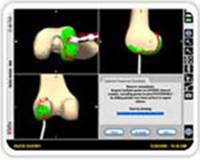
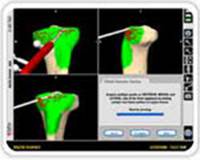
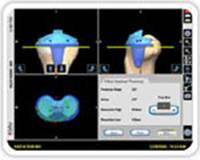
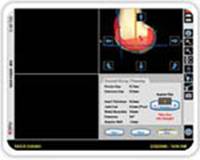
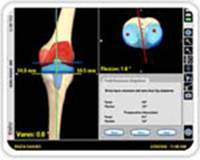
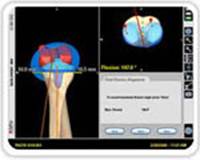
PICTURES ON COMPUTER SCREEN DURING KNEE REPLACEMENT SURGERY